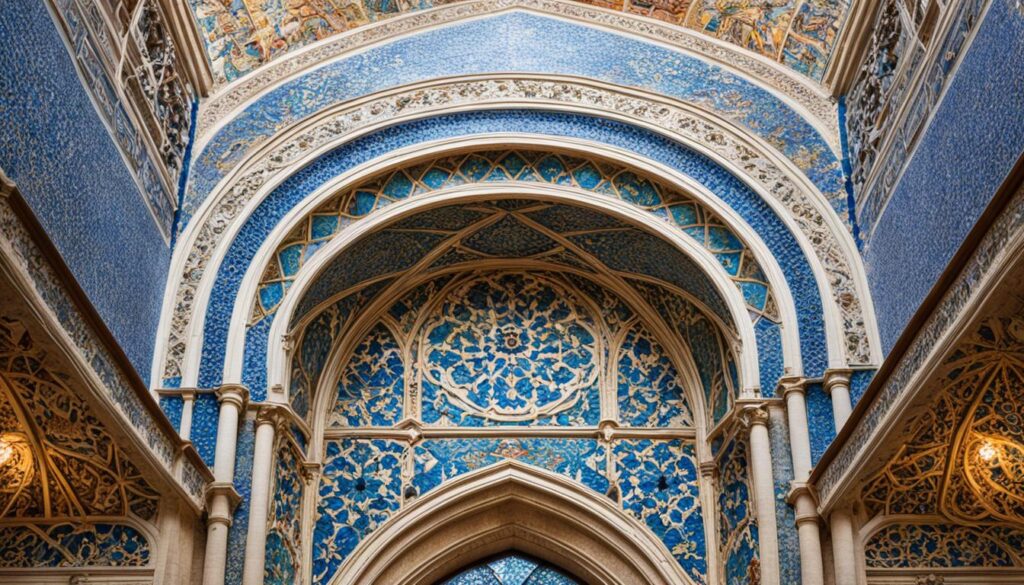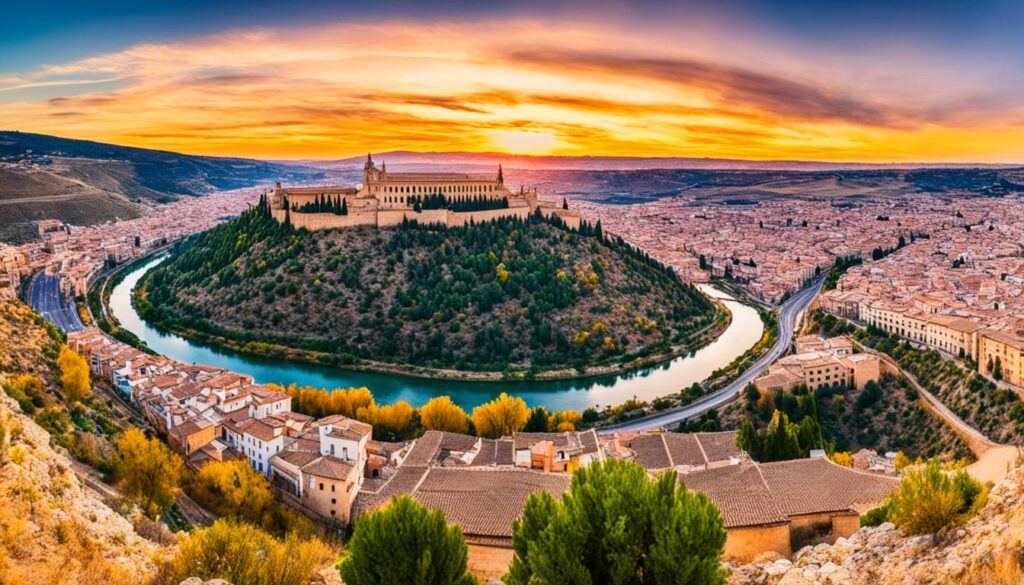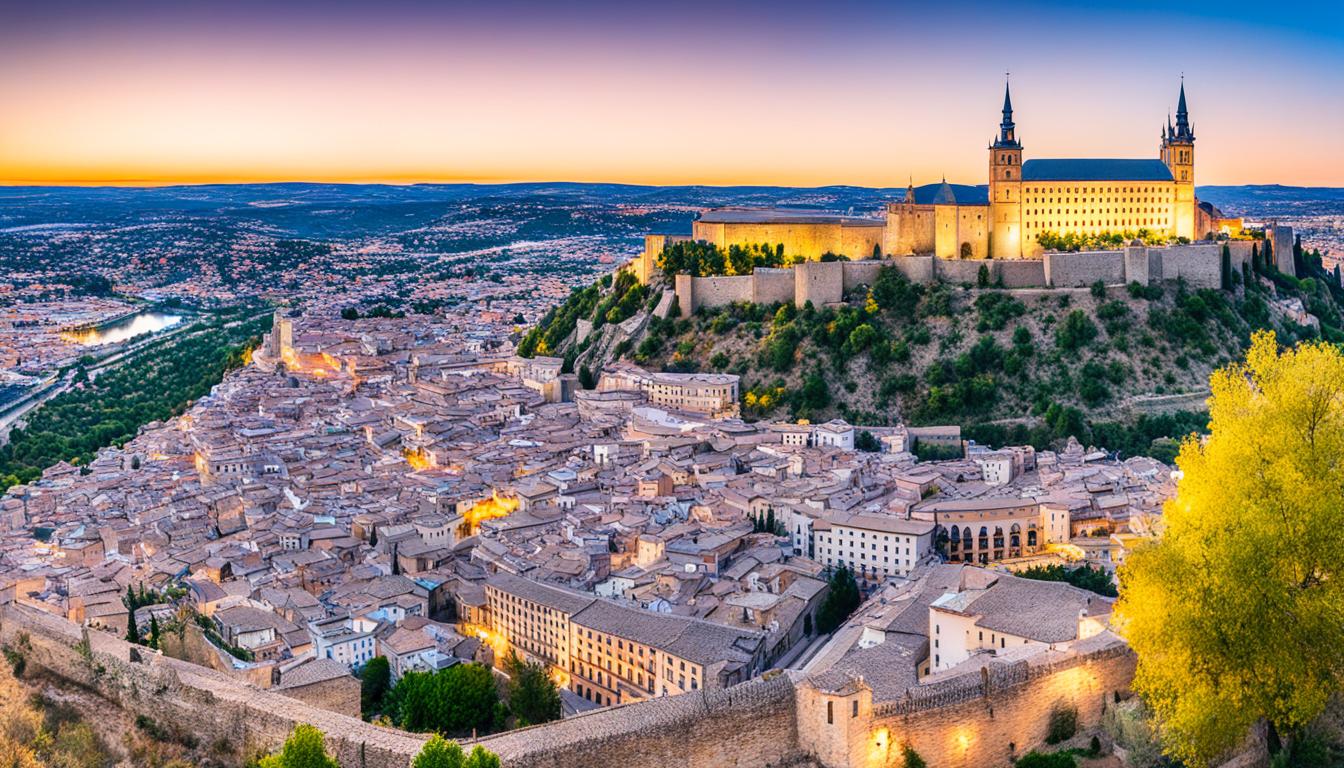Toledo is the heart of Spain, a UNESCO World Heritage Site full of history. It has Christian, Muslim, and Jewish cultures. This city sits on a hill and has narrow streets with amazing sights.
Here, you can see Gothic cathedrals, ancient synagogues, and Moorish mosques. You can visit the Alcázar fortress, the Toledo Cathedral, and see El Greco’s art. You can also try traditional crafts and foods.
Key Takeaways
- Toledo is a UNESCO World Heritage Site with a rich multi-cultural history
- The city boasts an impressive array of historic landmarks, including the Alcázar fortress and Toledo Cathedral
- Visitors can explore the Jewish quarter, Moorish influences, and the art of El Greco
- Traditional crafts and culinary experiences offer a glimpse into Toledo’s vibrant local culture
- The city’s scenic viewpoints and outdoor activities provide a modern contrast to its medieval roots
The Historic City of Three Cultures
Toledo is in Castilla-La Mancha and is a UNESCO World Heritage Site. It shows how Christian, Muslim, and Jewish cultures lived together for centuries. The city sits on a hill and has narrow streets filled with beautiful monuments. You’ll find Gothic cathedrals, ancient synagogues, and Moorish mosques.
Toledo is known as the “City of the Three Cultures” because of its history. The La Mezquita del Cristo de la Luz was a mosque in 999 and became a Christian church later. The Santa Maria la Blanca synagogue, now a church, also shows off Arabic architecture.
“Toledo is a city that has witnessed the coexistence of three major religions: Judaism, Christianity, and Islam. This unique blend of cultures has left an indelible mark on the city’s architecture and cultural landscape.”
The Catedral Primada de Santa Maria is a great example of Mudejar architecture. This style combines Muslim, Jewish, and Christian styles. Toledo was a key city in the Spanish Empire and was Charles V’s power center in the 16th century.
Today, Toledo shows how different cultures can live together. Its streets, monuments, and culture are a must-see for anyone interested in Spain’s history.
Alcázar of Toledo
The Alcázar stands tall in Toledo, a Moorish fortress on a hill. It was built on a Roman site and later updated by Christian Kings. Emperor Charles V added towers in the 16th century. During the Spanish Civil War, it was a Nationalist stronghold, honoring Franco’s supporters.
At the alcazar of toledo, you can see grand halls and courtyards. Now, it’s home to the Alcázar Military Museum. The museum displays historical items, weapons, and armor, showing Toledo’s military history. Climbing the towers gives you amazing views of the city and Castilla-La Mancha.
“The Alcázar of Toledo stands as a testament to the city’s tumultuous past, a symbol of its resilience and the enduring spirit of its people.”
If you love history or just want to see beautiful views, don’t miss the alcazar of toledo. Its stunning architecture and stories tell of Toledo’s past and its lasting impact.
Toledo Cathedral
The Toledo Cathedral stands tall in the historic city of Toledo. It’s a key Christian landmark in Spain. Built in the 13th century, it shows the city’s deep history and culture.
The cathedral is huge, stretching 120 meters long. It has 88 columns that are beautifully decorated. The stained-glass windows from the 14th to 16th centuries make the inside glow softly.
The Renaissance choir stalls are a big deal here. They are among the best art pieces in Christendom. The carvings show the skill of the artists who made them.
The Toledo Cathedral is full of Spanish history and culture. It has the Bible of San Luis from the 13th century. There’s also the monstrance used in the Corpus Christi parade since the 16th century.
If you like history, art, or beautiful buildings, you should visit the Toledo Cathedral. It’s a key spot in this amazing Spanish city.
toledo spain famous sites
Toledo is a city in central Spain that is full of history. It’s just an hour from Madrid and is a UNESCO World Heritage Site. This city is known for its toledo spain landmarks and toledo spain famous attractions. These sights show off Toledo’s unique culture.
The Old Town of Toledo is full of must-see landmarks. You can explore the history of its Jewish, Christian, and Muslim communities. Just walk the cobblestone streets and visit places like the Sinagoga del Tránsito and the Mezquita Cristo de la Luz.
- Monasterio de San Juan de los Reyes, a striking Flamboyant Gothic monastery
- Museo de Santa Cruz, a museum showcasing a collection of religious art and artifacts
- Mirador del Valle, a viewpoint offering sweeping vistas over the city’s historic skyline
The Toledo Cathedral is a must-see in Toledo. This huge Gothic cathedral is from the 13th century. It has beautiful columns, stunning stained-glass windows, and a choir with detailed carvings and Renaissance art.
“Toledo is a living museum, a city where the past is ever-present, and the legacy of its three cultures is woven into the fabric of everyday life.” – Anonymous
Toledo has architecture, history, and art that will capture your heart. It’s a city that promises an unforgettable visit. With so many toledo spain landmarks and toledo spain famous attractions, it’s a true gem of Spain’s culture.
Monasterio de San Juan de los Reyes
In the heart of Toledo lies the Monasterio de San Juan de los Reyes, a stunning example of late Gothic architecture. Founded in 1476 by King Ferdinand II and Queen Isabella I, this Franciscan convent is filled with history. It’s a place where the past comes alive.
The building started in 1477 and finished in 1504. It shows the Isabelline style popular during the Catholic Monarchs’ reign. The church is huge, 50 meters long and 30 meters tall, with a single nave. It has rib vaults and a star-shaped dome, making it breathtaking.
The main facade is a sight to behold, with statues and decorative details. The cloister, designed by Enrique Egas, has beautiful windows and animal motifs. It’s a peaceful spot for visitors to reflect.
This monastery is a treasure of late gothic architecture toledo. It’s perfect for history lovers, architecture fans, or anyone looking for peace. Don’t miss it when you’re in Toledo.
| Fact | Value |
|---|---|
| Year of Founding | 1477-1504 |
| Church Dimensions | 50m length, 30m height |
| Architectural Style | Isabelline (Late Gothic) |
| Restoration Timeline | 1883 – 1967 |
| Admission Fees | General: €2.80, Reduced: €2.40, Free for children and Toledo residents |
The Monasterio de San Juan de los Reyes is a san juan de los reyes monastery toledo with a rich history. It’s been beautifully restored for visitors to enjoy. Whether you’re walking through the cloisters, looking at the facade, or just enjoying the calm, this late gothic architecture toledo is unforgettable.
Sinagoga del Tránsito and Museo Sefardí
In the heart of Toledo, Spain, the Sinagoga del Tránsito stands out. It’s a symbol of the Sephardic heritage that once thrived here. Built in 1357, this synagogue is a key example of Sephardic architecture.
The synagogue is filled with beautiful patterns and writings in Arabic and Hebrew. Its high ceiling and detailed stucco show the mix of Islamic and Jewish cultures in Toledo. This mix is a result of the city’s history.
Next to the synagogue is the Museo Sefardí (Sephardic Museum). It tells the story of Spain’s Jewish community before the Inquisition. The museum opened in 1964 and has been updated since 2011 to make it easier to visit and protect the synagogue’s beauty.
| Sinagoga del Tránsito | Museo Sefardí |
|---|---|
|
|

“The Sinagoga del Tránsito is a significant example of mudéjar architecture, showcasing Islamic-inspired art and design elements from medieval Spain.”
Visiting the Sinagoga del Tránsito and the Museo Sefardí in Toledo is a must for anyone interested in sephardic architecture toledo or Spain’s Jewish history. It’s a key part of exploring Spain’s top tourist spots.
El Greco’s Masterpieces
Toledo is famous for the amazing works of El Greco, a famous Renaissance artist. He spent a lot of his career there. Visitors can see many of his famous paintings in this Spanish city.
El Greco’s first big project in Toledo was “The Disrobing of Christ (El Expolio)” from 1577 to 1579. He also did a series of six paintings showing high-status men in black with white ruffs. “The Nobleman With His Hand on His Chest” is one of these, made around 1580.
“The Burial of the Count Orgaz” is one of El Greco’s most famous paintings. It was made from 1586 to 1588 and is huge, measuring 15 by 11 feet. Another famous piece is “View of Toledo,” made from 1599 to 1600. It shows modern art styles, like Expressionism.
At the El Greco Museum in Toledo, you can see more of his famous works. These include “Christ Driving the Money Changers From the Temple,” “The Vision of Saint John,” and “Laocoön.” This last one might symbolize the Spanish Inquisition.
El Greco made a big impact in Toledo during his time there. His art still amazes and inspires people all over the world. His early and late works show his unique Mannerist style and the influence of Toledo. A visit to this Spanish city is a must for anyone who loves El Greco’s art.
Mirador del Valle Viewpoint
The Mirador del Valle viewpoint is a top spot for seeing Toledo. It’s perfect for hikers or those taking a shuttle. From here, you can see the city’s historic skyline and its mix of architectural styles over the years.
The Mirador del Valle is known as the best place to see Toledo’s beauty. It sits on a hill, giving you a wide view of the city’s old walls, gothic cathedrals, and ancient synagogues. It’s ideal for photographers or anyone wanting to dive into Toledo’s history.
“The view from the Mirador del Valle is simply breathtaking. It’s the perfect spot to appreciate Toledo’s stunning architecture and the harmony of its three cultures.”
There are more great toledo viewpoints to see, too. The Cerro de la Virgen de Gracia in the Jewish district shows off the Cathedral and Monasterio de San Juan de los Reyes. The Mirador de la Puerta del Sol is famous for its views of the old town and beyond.
Exploring the mirador del valle toledo or other viewpoints in Toledo is unforgettable. The panoramic views toledo will amaze you and make you love this Spanish city even more.

Traditional Crafts and Culinary Delights
Toledo is famous for its traditional crafts and tasty foods. You can find shops selling damascene metalwork, antique swords, and marzipan candies. These are local treats. The city’s food scene is a mix of classic Spanish dishes and new “gastrobar” foods.
The damascene metalwork is a key part of Toledo’s craft history. It’s a way of putting precious metals into steel. These beautiful pieces are sold in special shops. Toledo is also known for its handmade swords, showing its long history of sword-making.
Toledo’s food is a mix of Spanish, Moorish, and Jewish tastes. You can try dishes like migas and marzipan sweets. These foods are served in cozy tapas bars and restaurants, letting visitors enjoy Toledo’s food culture.

